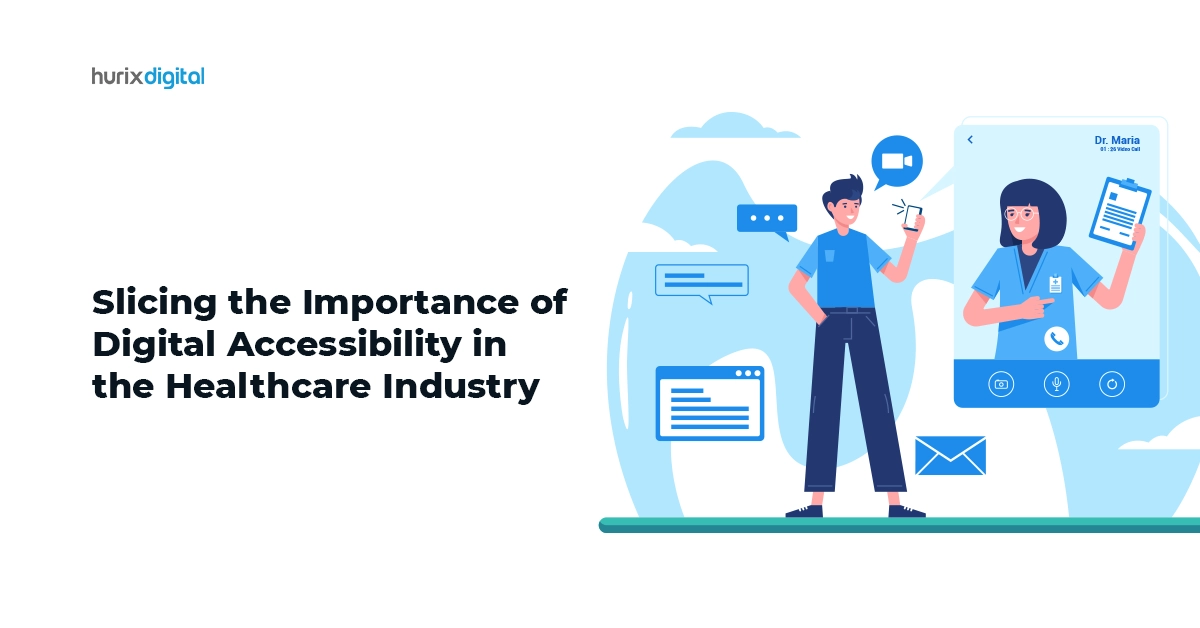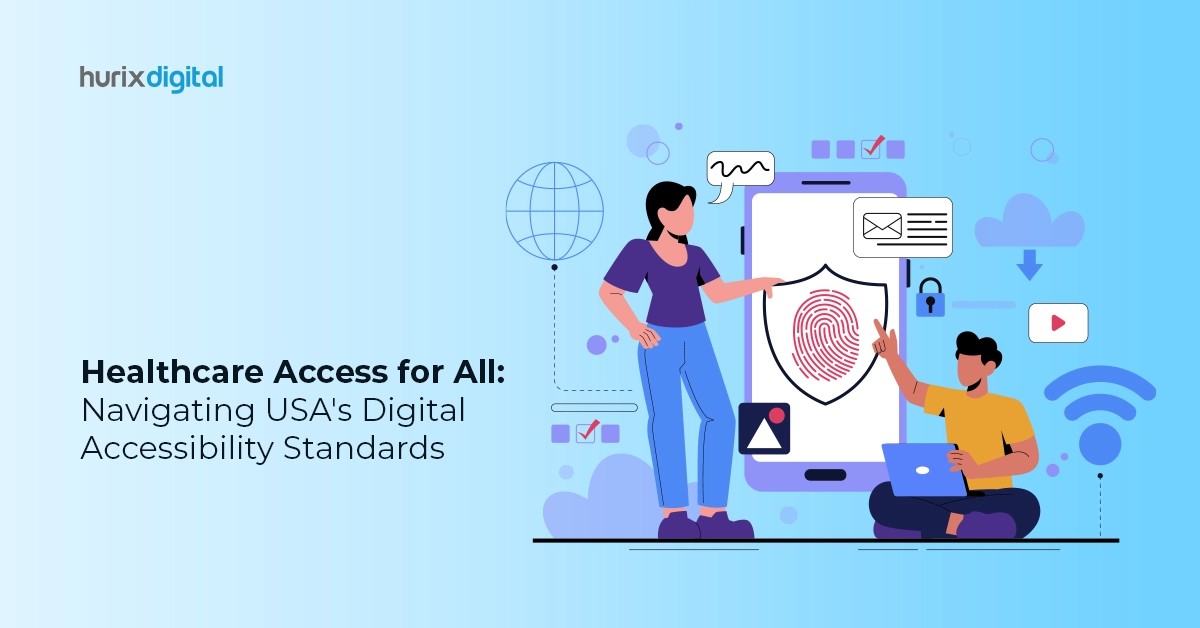Healthcare accessibility is essential in this era of technological advancement. Involving all primary digital tools helps healthcare reach as many people as possible, particularly those with vulnerable health needs. To maximize community health outcomes, strategies that improve healthcare accessibility show how scientists, healthcare providers, insurers, government regulators, and the community collaborate to translate science into practice.
Healthcare accessibility isn’t new for the industry and its users. Many healthcare institutes have offered access to assistive technology to people with disabilities since 1998, after the establishment of Section 504 Amendments to the Rehabilitation Act.
Healthcare technology has been the driving force behind helping people with disabilities get access without many difficulties. According to the report by Global Market Insight, the healthcare IT market size in 2022 was around $303.4 billion and is set to reach $1.1 trillion at a 13.5% CAGR by 2032. This report certainly presents how assistive technology is changing the face of the healthcare industry.
Table of Contents:
- A Complete Insight on Digital Accessibility in Healthcare
- Understanding the Importance of Healthcare Accessibility
- What are the Tips to Offer Healthcare Accessibility?
- Conclusion
A Complete Insight on Digital Accessibility in Healthcare
Over the past few decades, the healthcare industry has witnessed a significant uplift in adopting assistive technology. Moreover, new healthcare tools and technological advancements further pressure healthcare providers to offer cost-effective services. According to a report by the WHO, around 1.3 billion people, which is 16% of the total population, live with a disability.
Furthermore, people with disabilities frequently exhibit less satisfaction with their experiences receiving healthcare and face barriers to getting preventive medical services. Their specialized medical problems have limited their access to digital services, contributing to these discrepancies.
Healthcare institutes facing a lack of digital service might cause many problems for people with disabilities. These could include legal action by advocacy organizations and law firms, fines for breaking the Americans with Disabilities Act (ADA), termination from government employment, harm to one’s reputation, and a decrease in the number of new patients.
Digital accessibility is an extended version of assistive technology guided by the principles of the ADA. Inclusive healthcare involves facilitating closed captioning on videos that facilitate reading for individuals who are deaf or hard of hearing. At the same time, audiobooks convert text to speech for those who are blind or partially sighted.
Also Read: How Can Your Business Comply with WCAG 2.2 Seamlessly?
Understanding the Importance of Healthcare Accessibility
Healthcare institutes believe that healthcare assistance reaches disabled people, but the reality is different. The lack of aid lets us know the importance of healthcare accessibility-
1. Improving Patient Outcomes
By making vital health information and services accessible to people with impairments, digital accessibility can help enhance patient outcomes. For instance, audio transcripts and captioned videos might be helpful to people who have hearing loss.
On the other hand, options like screen readers and text descriptions can be beneficial for visually impaired people.
2. Using Websites and Apps for Easy Access
Many disabled people face issues with web accessibility or even the app due to impairment.
Healthcare institutes must provide a mobile application and website that prioritizes accessibility for individuals with impairments. Include features like keyboard navigation choices, videos with captions, and photo alt-text. Determine and remove any obstacles that might impede people with impairments. Use huge fonts, allowing up to 300% magnification while maintaining text visibility and resolution-preserving image scaling.
You can even include speech recognition and a color-blind mode. Ensure that every link can be easily identified and that everyone can easily navigate the website, thanks to its well-designed navigation.
3. Getting Broad Patient Feedback
Not all patients can give feedback about the healthcare service offered due to multiple physical challenges. There could be various scenarios for facing hurdles to web accessibility. For example-
- Patients who underwent hand surgery may find it difficult to type or navigate the site.
- Elderly patients with eye impairment may find reading the content on an app or website hard.
Like these, many other scenarios could demand healthcare technology tools for easy accessibility.
4. Meeting Regulatory Demands
Healthcare institutes across the US and others must comply with rules led by the ADA and the Web Content Accessibility Guidelines (WCAG). Any healthcare provider failing to comply with the guidelines may face legal consequences, damaging its reputation.
What are the Tips to Offer Healthcare Accessibility?
To help the maximum disabled population, it is important to understand ways to offer healthcare accessibility. Some of these are:
1. Integrate Assistive Technology
Integrating assistive technology into your healthcare service can be helpful, especially to those facing complex tasks like typing, reading screens, and using touch-screen smartphones. Healthcare websites allow users to schedule appointments, view information about services, and get test results by integrating with assistive technology.
2. Offer Substitute Formats
Alternative formats could be necessary for people with disabilities to have web accessibility. Including audio descriptions, diagrams, charts, and other visual formats is best.
3. Test Tools with Disabled People
When it comes to digital accessibility, healthcare institutes usually make mistakes by not testing the tool with disabled people before launching it. Instead, it is imperative to actively include people with different types of disabilities in the testing process for mobile versions, apps, and websites.
By performing functional and manual testing, they can uncover potential problems and report on them, offering insightful information.
4. Appoint Web Accessibility Experts
The best way to make error-free healthcare accessible is by hiring an experienced coordination team that handles legal aspects and other policies. Moreover, it would help if you had a team digitize that content in different formats, making it accessible to disabled people. Everything is done under ADA law.
5. Empower Employees with Awareness
Before making assistive technology available to patients, it is essential to empower the staff with tools through training and courses. Ensure your team has access to accessibility and training by reviewing your professional development budget and carrying it out.
6. Give Your Staff a Firsthand Look
Distribute videos that depict the inaccessible platform’s user experience. Urge technologists and designers to utilize an extension or to screen-read websites while wearing a blindfold.
Also Read: How to Improve Accessibility in Healthcare Setting
Conclusion
Healthcare accessibility has the power to reach beyond boundaries. Digital accessibility can be advantageous for elderly people who reside far from medical professionals, for example. Several factors influence people’s access to these tools, including remote access, lower infection risk, and real-time medical advice.
While it may seem overwhelming to start the journey toward digital accessibility in healthcare, following these recommendations might serve as a helpful starting point. By ensuring digital accessibility, healthcare professionals can narrow care gaps, foster inclusivity, and make healthcare services accessible.
Hurix Digital is a frontrunner in offering healthcare accessibility products through custom software development and hospital learning technology services. Get in touch with us to help your healthcare service reach out to a broader audience.







